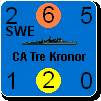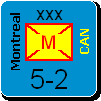Shannon V. OKeets
Posts: 22095
Joined: 5/19/2005
From: Honolulu, Hawaii
Status: offline

|
quote:
ORIGINAL: Froonp
quote:
ORIGINAL: Shannon V. OKeets
I am closing in on fully understanding all the possible sequences of events for instigating naval movement. Due solely to the ablity of players to intercept naval movement, a backlog of naval moves can accumulate, which in programming terms is a push down stack. That's very easy to program and once understood at this abstract level, it's also easy to think about while writing related code.
But I have one question about naval interceptions.
Suppose a Japanese naval group moves into a sea area occupied by both the US and CW, both of whom are at war with Japan. Do both the US and CW players get an opportunity to intercept (this is how I read the rules), or should the decision be given to one player to decide on behalf of his side (this is how it was coded in CWIF)?
I think that this is moot as rule says :
********************************
As long as that face-down unit remains in the sea-box, you can make further interception attempts in that sea area against other task forces during the same impulse without having to turn over another unit. If that unit is in the sea-box during naval combat, it also allows you to attempt to start a naval combat there without having to turn another unit face-down (see 11.6). If the face-down unit aborts or is destroyed, you would have to turn over another unit to make another interception attempt or to start a combat in that sea area.
********************************
In that, what makes me think that it is moot is that it says "against other task forces during the same impulse without having to turn over another unit". So even if after the US have tried to intercept, the CW wants to intercept too, he will only be able to intecept another TF.
I understand it that there is only 1 intercept attempt per sea area per side (Allies / Axis), in the same way as there is only 1 naval combat attempt per sea area (after the moves) per side (Allies OR Axis), there is not even one per side.
Also, it says :
********************************
Interception attempt fails
If the interception attempt fails, the moving force continues as if nothing had happened.
********************************
So, if the interception fail, no one get the opportunity to intercept it again, the "moving force continues as if nothing had happened".
The End of interception part also says that after the fight is over, the moving TF resumes moving.
So the answer is : The decision be given to one player to decide on behalf of his side.
The problem that might arise is the US player saying he wants to intercept using one of the CW units . .
I am going to let all major powers that could intercept do so. If they all decline, then so be it. If one of them says Yes, then I'll ignore what the others might have to say. The major power that says Yes has to use one of his units to perform the interception.
This might seem minor, and is irrelevant when one player plays all the major powers on a side, but I am allowing for 6 players in a game. So it might come up.
_____________________________
Steve
Perfection is an elusive goal.
|
 Printable Version
Printable Version






 .
. 

 New Messages
New Messages No New Messages
No New Messages Hot Topic w/ New Messages
Hot Topic w/ New Messages Hot Topic w/o New Messages
Hot Topic w/o New Messages Locked w/ New Messages
Locked w/ New Messages Locked w/o New Messages
Locked w/o New Messages Post New Thread
Post New Thread